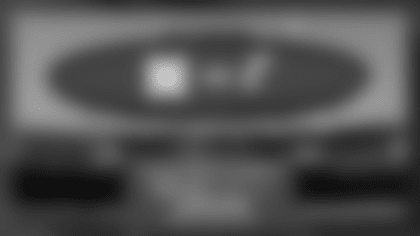From the slot, Tyreek Hill raced into motion towards the backfield. Alex Smith, who was in shotgun with Kareem Hunt just to his right, bent slightly at the waist as Hill—the NFL's fastest player—went whizzing past him.
Hill's action forced the New England Patriots' defense to react quickly. The deep safety quickly fired downhill on Hill to the flat, while at the same time, Hunt snuck out of the backfield as Travis Kelce, who was lined up inline on the opposite side of where Hill began, ran a crossing route.
The design of the play put plenty of pressure on Patriots' safety Eric Rowe, who was initially lined up on Hill in the slot but didn't follow him across the formation, but rather replaced the safety who came down on Hill.
As the play developed and as soon as Kelce flashed across the middle of the field, Rowe, who was coming from the opposite side, naturally re-directed his momentum the other way and followed Kelce.
This movement opened up the middle of the field for Hunt, who ran a little vertical post route coming out of the backfield on the same side of the formation that Hill was headed.
Hunt, who had a linebacker trailing him in coverage, beat his guy down the field as Smith read it the whole way and dropped him a dime. Hunt brought it in and raced 78 yards for the touchdown to give the Chiefs an early fourth quarter lead.
The choreographed motion of this play coming together had to be a beautiful sight for those who pressed and worked over the smallest details to make it go from a concept to being called in a key moment of one of the defining wins of the season for any team so far this year.
But was the success of this play more about the design, or the execution?
It's an interesting debate for a Chiefs' offense that has seen plenty of big plays this season.
Through 10 weeks, the Chiefs not only lead the NFL by averaging 6.22 yards per play, but they also lead the league with 110 points scored from outside the red zone. Simply put, big plays have become the norm for this offense.
So, who gets most of the credit? The coaches for the design of the play, or the players for executing it?
After speaking with a handful of players and coaches, the answer is naturally, both.
"Some of these [plays] we've worked since training camp," Chiefs coach Andy Reid explained earlier this week. "You've seen that and we're just kind of pulling them out and using them now. And then other plays you kind of create as you go and you keep track of the pluses and the minuses on the newer things that you add, and we're very critical of that and time goes into that, and most of all the players' execution—they take to those things.
"They enjoy the challenge, so my hat goes off to them for trusting us when we bring something new in."
With several hundred, if not a thousand, total plays in the playbook, which get whittled down to less than a hundred in the game plan each week, the reps during practice become paramount to the ability to successfully execute each of these plays on game day.
"We work it a lot during the week, definitely walk through different looks of it," rookie running back Kareem Hunt explained. "Like, if it's this type of look we'll go ahead and do it this way or block it this way, or if it's it like this look we'll do it running this way."
Part of the film session that coaches and players have each week is about going through how each play would be executed against the different looks they might see from the defense. They don't have time to see all of the variations of looks while outside at practice. This film time is crucial for the answers to things that will pop up during the game.
"You try to get some looks that you might not know as well," Chiefs' offensive coordinator Matt Nagy explained. "For instance, if there's a play designed for man (coverage) and we put it in in training camp and we know how to run it in our sleep versus man coverage, and that play is brought up for this week, we may try to run it verse a zone coverage that we think they're going to run, just so that we know how to adjust.
"If they give us a man in the game, then we react."
"We can sit there and try to draw up schemes, formations, and plays, and you try to predict coverages and you know 50 percent of the time that happens, maybe 60, that you get the coverage and the perfect play," Nagy added. "So, most of it is execution. But at the same time, there are parts of that execution that they're practicing Wednesday through Friday on the different looks they could see, so where we're trying to give them different looks to understand how to run that route."
It's not as simple as running the play that's written down on a sheet. There are checks that determine what each skill position player is doing on any given play, and they're always changing.
It's more of a play concept than a play call, and Hunt's touchdown against the Patriots was a good example of both a great play design as well as good execution.
And another player who hasn't been a stranger to the big play throughout this season and his short career thus far is Tyreek Hill, who has averaged 49.23 yards per play on his 17 touchdowns in 25 career games.
Hill's 64-yard touchdown catch against the Oakland Raiders earlier this year was about him simply using his blazing speed to get down the field, but it was also only possible because of proper execution in the backfield.
The deep throw-and-catch and subsequent celebration might be what ultimately made it on the highlight reel, but the only reason that play happened was because of what Hunt did before the pass was even thrown.
"With [Hunt] stepping up and making the block, he allowed us to make that play," quarterback Alex Smith explained.
The success of that play was about the execution and natural ability of Hill, but also the fulfillment of the design of the pass protection from Hunt. Again, it was a perfectly choreographed dance with everyone on beat and on step.
As far as planning for those big plays during the week, Smith said it's hit or miss because the defenses are also always adjusting.
"There are weeks we see things and design a play that's specifically a product of something we see on film," Smith explained. "We design a play hoping for a big play. I think that's a little bit of magic of two things, coach seeing it and designing it, and us getting it down in a week's time and then going out and pinning it against the right look too. You have to get all those things right."
Smith said it's often the case that some of the best plays they design and discuss during the week aren't even used.
"There are so many weeks where we had plays in the game plan that we think are going to be the best, and then it gets called but you never get the right look and we never get to even show it or try to hit it because it was really kind of particular to the one thing they were doing on film," Smith explained. "So, that happens quite a bit too, and it never shows so no one really knows except us that we didn't get it.
"There's just so many different little chess matches going on like that—that's just part of the deal on game day. Coach [Reid] is doing the best he can to call it, but he doesn't know what they're doing."
But when the right play is called and the defense is lined up exactly how they thought they would be based on their prep work during the week, Smith said it's actually pretty easy to not get overly excited.
"You see it and you throw it like a trigger," Smith said. "You don't really have time to be thinking about all the other stuff. That's all part of the mentality and responsibility (of playing the quarterback position). If the look is there, you've got to be able to pull the trigger and hit it, and if not, you've got to be able to protect and go to the next play."
Nagy said the hardest part of that chess match is not to overthink the whole thing and spend too much time guessing how a defense could react.
"If you don't balance that and you outthink yourself—most of the time you're going to be wrong," Nagy added. "So, by the time you do all this you end up picking it and it's wrong instead of just going with your gut instinct and following it and then letting the players react."
Reid, Nagy, and company have let the players react enough to the tune of 133 plays on the year so far that have resulted in gains of 10 yards or more, which ranks third in the NFL.
Furthermore, the Chiefs had 11 touchdown passes thrown of at least 10 yards last year, and through nine games, they already have 12 this year. The big play has become a staple of the Chiefs' offense.
In the end, it really doesn't matter who gets the credit for the big plays because everyone involved—from the players making the plays to the coaches teaching them how to adapt to each look, and even to the scout team guys who are giving them the right look during the week—should share in the credit.
And with a game on Sunday that pins a Chiefs' offense that leads the league with eight touchdowns of 40-plus yards against a Giants' defense that has allowed a league-most five touchdowns of at least 40 yards this season, the debate of who gets credit will hopefully continue on into next week and beyond.













